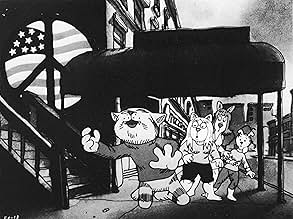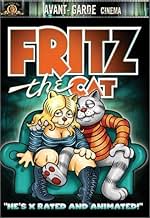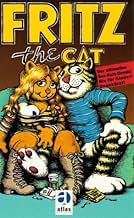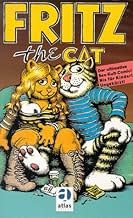CALIFICACIÓN DE IMDb
6.2/10
15 k
TU CALIFICACIÓN
Ambientada en los barrios populares de Nueva York. La historia se desarrolla en la década de los 60, gira alrededor de un gato pervertido en su búsqueda del amor en los lugares menos indicad... Leer todoAmbientada en los barrios populares de Nueva York. La historia se desarrolla en la década de los 60, gira alrededor de un gato pervertido en su búsqueda del amor en los lugares menos indicados.Ambientada en los barrios populares de Nueva York. La historia se desarrolla en la década de los 60, gira alrededor de un gato pervertido en su búsqueda del amor en los lugares menos indicados.
- Dirección
- Guionistas
- Elenco
Rosetta LeNoire
- Bertha
- (voz)
- …
John McCurry
- Blue
- (voz)
- …
Ralph Bakshi
- Narrator
- (voz)
- (sin créditos)
- …
Charles Spidar
- Bar Patron
- (voz)
- (sin créditos)
- …
- Dirección
- Guionistas
- Todo el elenco y el equipo
- Producción, taquilla y más en IMDbPro
Opiniones destacadas
The story concerns a classic 60's hero, Fritz, and his adventures through the urban underground
He loves sex and constantly claims and declares the glories of revolution
At first he is happy with just sex, but as the story moves through exotic adventures he discovers that the only way he can truly be a revolutionary is to join up with one of the militant groups
There, he's over his head
In sharp contrast to Walt Disney's soft characters, Fritz is seen providing a bunch of screaming female cats, placing drugs, and having lots of fun We are taken through Harlem where, in this case, the blacks are portrayed as jive-talking crows Fritz is not a fantasy, but an animation venture into super-reality, at least as Bakshi sees it
The animation is unpolished, graceless, but very effective It has an unrefined or unfinished, renewable energy that brings out some of the social results of the confused sixties
In sharp contrast to Walt Disney's soft characters, Fritz is seen providing a bunch of screaming female cats, placing drugs, and having lots of fun We are taken through Harlem where, in this case, the blacks are portrayed as jive-talking crows Fritz is not a fantasy, but an animation venture into super-reality, at least as Bakshi sees it
The animation is unpolished, graceless, but very effective It has an unrefined or unfinished, renewable energy that brings out some of the social results of the confused sixties
I'll take back every negative thing I said about Ralph Bakshi. I gave "Wizards" a second chance and now, instead of saying it was "An Animated Mess," it is a cult classic that works as comedy. It took me a while to warm up to Bakshi, but the more I got used to him, I am now declaring him not only as "The Bad Boy of Animation," because that's what he always intended to be, but also as what I really want to think of him as - The Mel Brooks of animation - because his style is really hilarious, whether he intended on this or not. Take this as a compliment, Ralph, you are a very funny guy. Your work seems angry, but you make me laugh.
As for his movies, many of them are not for children, especially young ones. "Fritz the Cat" is his first, his foremost, and one of his best. But it is rated X, and the first theatrical cartoon to be rated X with all the cartoon nudity, graphic violence, and foul language. Here's a piece of trivia: Would anyone guess that the man doing the voice of Fritz the cat is actually Skip Hinnant, the same guy from the children's PBS educational show "The Electric Company" who played Fargo North, Decoder, and Hinnant worked on "Fritz" and "The Electric Company" in the same year? It's true, two vastly different worlds, but Hinnant has pleased both children and adults, and not necessarily at the same time.
Now let's cut to the movie. It may seem like a dumb adult cartoon, but it does make a statement about the hedonistic lifestyles of the 1960's and there is a lot of allegorical symbolism. Fritz and his fellow felines (looks at his three females in the bathtub scene) represents the sexual revolution, the crows represent low-life Negroes who engage in crime, rioting in Harlem, and pot-smoking, the pigs represent cops who chase Fritz everywhere and are out to bust Fritz, and there's a sadistic witch-like lizard who represents radical culture of the hippies and enjoys watching her rabbit friend beat up Fritz and his donkey girlfriend Harriet with a chain in a sanctuary.
There's something to offend everyone in Fritz, right down to the bathtub orgy in the beginning of the film, heavy dosages of full frontal nudity, hallucinations of bare breasts, Big Bertha, the floozy black crow who seduces Fritz by stuffing marijuana into his mouth, rabbis who get interrupted by Fritz fleeing from the police, a typical 1960's riot in Harlem started by big-mouthed Fritz, pigs as rogue cops (Notice that Ralph Bakshi does the voice of one of the cops who says "Duh. In fact, he mentioned he does all the "Duh" voices in his movies as part of his commentary track from "Wizards." In "Fritz," Bakshi calls his fellow partner, "Ralph," so no one will think that Bakshi is doing the voice of "Ralph," so to speak.), lizards as evil witches, and the list goes on.
The best thing about "Fritz" is that Bakshi seemed to have a lot of fun doing this, and everything worked. He really added the fun to "Heavy Traffic" and "Wizards." When Bakshi really wanted to do an adult animated film, it can work. It only got deadening with latter overproduced efforts such as "Lord of the Rings" and "Cool World," and one can easily see that Bakshi labored everything, rather than the naturalism in "Fritz," "Heavy Traffic" and "Wizards."
Today, adult animation is popular now on TV. In the 1970's, adult animation was used for the theater. Younger animators such as Trey Parker and Matt Stone, the creators of "South Park," and Seth McFarlane, the creator of "Family Guy," appear to be working under the influence of Bakshi, incorporating every bit of lewdness they could think of for their shows and characters. But it is really Bakshi who fathered adult animation, and Parker, Stone, and McFarlane are like his sons, and father knew best.
As for his movies, many of them are not for children, especially young ones. "Fritz the Cat" is his first, his foremost, and one of his best. But it is rated X, and the first theatrical cartoon to be rated X with all the cartoon nudity, graphic violence, and foul language. Here's a piece of trivia: Would anyone guess that the man doing the voice of Fritz the cat is actually Skip Hinnant, the same guy from the children's PBS educational show "The Electric Company" who played Fargo North, Decoder, and Hinnant worked on "Fritz" and "The Electric Company" in the same year? It's true, two vastly different worlds, but Hinnant has pleased both children and adults, and not necessarily at the same time.
Now let's cut to the movie. It may seem like a dumb adult cartoon, but it does make a statement about the hedonistic lifestyles of the 1960's and there is a lot of allegorical symbolism. Fritz and his fellow felines (looks at his three females in the bathtub scene) represents the sexual revolution, the crows represent low-life Negroes who engage in crime, rioting in Harlem, and pot-smoking, the pigs represent cops who chase Fritz everywhere and are out to bust Fritz, and there's a sadistic witch-like lizard who represents radical culture of the hippies and enjoys watching her rabbit friend beat up Fritz and his donkey girlfriend Harriet with a chain in a sanctuary.
There's something to offend everyone in Fritz, right down to the bathtub orgy in the beginning of the film, heavy dosages of full frontal nudity, hallucinations of bare breasts, Big Bertha, the floozy black crow who seduces Fritz by stuffing marijuana into his mouth, rabbis who get interrupted by Fritz fleeing from the police, a typical 1960's riot in Harlem started by big-mouthed Fritz, pigs as rogue cops (Notice that Ralph Bakshi does the voice of one of the cops who says "Duh. In fact, he mentioned he does all the "Duh" voices in his movies as part of his commentary track from "Wizards." In "Fritz," Bakshi calls his fellow partner, "Ralph," so no one will think that Bakshi is doing the voice of "Ralph," so to speak.), lizards as evil witches, and the list goes on.
The best thing about "Fritz" is that Bakshi seemed to have a lot of fun doing this, and everything worked. He really added the fun to "Heavy Traffic" and "Wizards." When Bakshi really wanted to do an adult animated film, it can work. It only got deadening with latter overproduced efforts such as "Lord of the Rings" and "Cool World," and one can easily see that Bakshi labored everything, rather than the naturalism in "Fritz," "Heavy Traffic" and "Wizards."
Today, adult animation is popular now on TV. In the 1970's, adult animation was used for the theater. Younger animators such as Trey Parker and Matt Stone, the creators of "South Park," and Seth McFarlane, the creator of "Family Guy," appear to be working under the influence of Bakshi, incorporating every bit of lewdness they could think of for their shows and characters. But it is really Bakshi who fathered adult animation, and Parker, Stone, and McFarlane are like his sons, and father knew best.
Anyone who didn't like Fritz the Cat is not looking at the film in the right way. A lot of the reviews I've read basically said that it is nothing more than a bad film that strives only on shock value to get an audience. I also read that it doesn't have much of a storyline and only revolves around sex and drugs......so what else did you expect a movie about the slackers of the 60s to have? Did the stoners of that decade NOT behave the way Fritz does in the movie? In order to understand the point of the movie you have to put yourself into Fritz's shoes and let him guide you through his life as a college drop-out trying to find his purpose (Existentialism for those who are not familiar with philosophy) in life and still have a good time. Of course his journey leads you to animal orgies and a crow that hides pot in awkward places, but that is the beauty of this movie--it's about freedom! I also do not believe it is outdated because Fritz's trippy surroundings and his pseudo-intellectual thoughts were enough to make me melt! It's all about the mood. The animation and music put the viewer in a hypnotic state where nothing else matters except pleasure and happiness. If you can't identify with Fritz then you have lost the feel of what it's like being young.
And just for some peoples' info. the movie is not X-rated because it has explicit sex scenes (any viewer of pornography, also X-rated in some form, knows that we have seen much more of the human body then is depicted in this film), it is X-rated because there are CARTOON ANIMALS HAVING SEX. Anyone who would give this film an R-rating because there are no close-ups should not plan on an MPAA career in the near future
And just for some peoples' info. the movie is not X-rated because it has explicit sex scenes (any viewer of pornography, also X-rated in some form, knows that we have seen much more of the human body then is depicted in this film), it is X-rated because there are CARTOON ANIMALS HAVING SEX. Anyone who would give this film an R-rating because there are no close-ups should not plan on an MPAA career in the near future
From what I had heard of this film and the other user comments posted, I was expecting a simple little shock cartoon. What I got was good kick in the pants. And I mean that in a good way. "Fritz the Cat" in many ways exposes the 1960's more than the live action films of its own decade.
The movie starts with 3 construction workers talking on top of an unfinished building. The dialogue is very spontaneous and almost seems ad-libbed. These types of conversations are sprinkled throughout the 80 minute film.
It then transitions to Fritz the cat, a college student who, like many of that era I'm sure, is not sure what it's all for. He decides to "do something real" and ventures into Harlem. From here he meets a wide assortment of people, incites a riot, and has sex with many a woman. It may not always have a point, but the movie has one fun segment after another with little breathing room. Sometimes unnecessarily shocking, sometimes surprisingly inspired, but always quick on its feet.
So please give it a chance. It's a lot more than the notorious cartoon porn it's been labeled as. It's a fun romp through the deprived New York of the 60's, except this time with cartoon characters! What's not to like?
7/10
The movie starts with 3 construction workers talking on top of an unfinished building. The dialogue is very spontaneous and almost seems ad-libbed. These types of conversations are sprinkled throughout the 80 minute film.
It then transitions to Fritz the cat, a college student who, like many of that era I'm sure, is not sure what it's all for. He decides to "do something real" and ventures into Harlem. From here he meets a wide assortment of people, incites a riot, and has sex with many a woman. It may not always have a point, but the movie has one fun segment after another with little breathing room. Sometimes unnecessarily shocking, sometimes surprisingly inspired, but always quick on its feet.
So please give it a chance. It's a lot more than the notorious cartoon porn it's been labeled as. It's a fun romp through the deprived New York of the 60's, except this time with cartoon characters! What's not to like?
7/10
The bad thing about the past is that it is designed to fool you.
The idea is supposed to be that the past stays fixed, as a sort of "truth." And we change. But viewed from ourselves, often the illusion or even the truth is the reverse. We know who we are. We think we recall who we were -- which we envision is some state on the way to who we are. Something relatively static, which means that the past changes. Radically.
Or at least artifacts from the past change, artifacts like movies. All this is complicated by the fact that movies are a key tool we use to define ourselves.
So it is a strange trip indeed to encounter something that DID define us, that we allowed to tell us who we were. And to find it so vacuous, so superficial it shocks.
If you were not a hippie in that era you may need to know the great schisms at work. (I mean the era depicted here -- 1969 -- not the actual date of the movie.)
You had the east coast hippies who were the sons and daughters of the beat generation. We were interested in ideas and art, and life as both. You had the "political" hippies, who were motivated by unhappiness and determined to change what they didn't like in the name of the values of more "genuine" hippies.
And then you had the west coast hippies. These were the ones captured by drugs, "free" sex and dropping out. To differentiate themselves, they adopted the icons of death.
At the time, there was as much confusion among these three as between any one of them and the Nixonites. (This was in the days of the "moral majority" and before the rise of the religious right which evolved from it.)
And where there is is identity confusion, art rushes in. The Beatles of course, and central. Eastern "religions."
And R Crumb.
Crumb was a magnet, pulling many from the other camps into the west coast sphere. He made it seem less radical than it was -- more about cruising (which he called "truckin") and simply enjoying the cornucopia of round women God places there only for pleasure.
We bought it, all of us. It was a sort of commercial identity, sort of like what you see today that surrounds Valentine's day. A vague notion of self and others and satisfied living.
Now, we look at this and it seems the past has moved away from us, away from truth. Was this ever good, or did we only pretend it so because we were so hungry to be defined?
I recently saw a Mickey Rooney movie where he introduces himself to Judy Garland as "white, free and available." I recoiled. I rejected that past. I had nearly the same feeling when watching this, even though it is/was my past.
Ted's Evaluation -- 1 of 3: You can find something better to do with this part of your life.
The idea is supposed to be that the past stays fixed, as a sort of "truth." And we change. But viewed from ourselves, often the illusion or even the truth is the reverse. We know who we are. We think we recall who we were -- which we envision is some state on the way to who we are. Something relatively static, which means that the past changes. Radically.
Or at least artifacts from the past change, artifacts like movies. All this is complicated by the fact that movies are a key tool we use to define ourselves.
So it is a strange trip indeed to encounter something that DID define us, that we allowed to tell us who we were. And to find it so vacuous, so superficial it shocks.
If you were not a hippie in that era you may need to know the great schisms at work. (I mean the era depicted here -- 1969 -- not the actual date of the movie.)
You had the east coast hippies who were the sons and daughters of the beat generation. We were interested in ideas and art, and life as both. You had the "political" hippies, who were motivated by unhappiness and determined to change what they didn't like in the name of the values of more "genuine" hippies.
And then you had the west coast hippies. These were the ones captured by drugs, "free" sex and dropping out. To differentiate themselves, they adopted the icons of death.
At the time, there was as much confusion among these three as between any one of them and the Nixonites. (This was in the days of the "moral majority" and before the rise of the religious right which evolved from it.)
And where there is is identity confusion, art rushes in. The Beatles of course, and central. Eastern "religions."
And R Crumb.
Crumb was a magnet, pulling many from the other camps into the west coast sphere. He made it seem less radical than it was -- more about cruising (which he called "truckin") and simply enjoying the cornucopia of round women God places there only for pleasure.
We bought it, all of us. It was a sort of commercial identity, sort of like what you see today that surrounds Valentine's day. A vague notion of self and others and satisfied living.
Now, we look at this and it seems the past has moved away from us, away from truth. Was this ever good, or did we only pretend it so because we were so hungry to be defined?
I recently saw a Mickey Rooney movie where he introduces himself to Judy Garland as "white, free and available." I recoiled. I rejected that past. I had nearly the same feeling when watching this, even though it is/was my past.
Ted's Evaluation -- 1 of 3: You can find something better to do with this part of your life.
¿Sabías que…?
- TriviaThere is no evidence that Robert Crumb filed suit to have his name removed from the film's credits. Contradictory to this claim, Crumb's name continues to appear in the credits, even on home media releases. His name, however, does not appear in the credits for Las nueve vidas eróticas del gato Fritz (1974).
- ErroresWhen he emerges from the trash can, Fritz's outfit changes color from red to blue to red again between shots.
- Versiones alternativasWhen aired during the Groundbreakers block on Playboy, the scene of Harriet's rape is heavily edited. The movie is otherwise uncut.
- ConexionesFeatured in Precious Images (1986)
Selecciones populares
Inicia sesión para calificar y agrega a la lista de videos para obtener recomendaciones personalizadas
- How long is Fritz the Cat?Con tecnología de Alexa
Detalles
Taquilla
- Presupuesto
- USD 700,000 (estimado)
- Tiempo de ejecución1 hora 18 minutos
- Color
Contribuir a esta página
Sugiere una edición o agrega el contenido que falta

Principales brechas de datos
What is the French language plot outline for Fritz el gato (1972)?
Responda
























